| ECONOMIC
OUTLOOK |
| |
| 2005
IN REVIEW |
 |
The Alberta economy
grew by an estimated 4.3 per cent in 2005, the best performance
of any province for the second consecutive year. Over the past fifteen
years, Alberta's economic growth has exceeded the national average
twelve times.
High energy prices, along with strong
investment and consumer spending, have fuelled the Alberta economy.
- Alberta's energy sector continued
to benefit from higher oil and gas prices in 2005. Strong global
demand and low world spare capacity for oil drove prices to an
estimated average US$60/bbl in 2005-06, up 33 per cent from 2004-05.
Natural gas prices followed the high price of oil early in the
fiscal year and then spiked in late August after two hurricanes
disrupted production along the U.S. Gulf Coast, resulting in an
estimated average price of C$8.40 per GJ in 2005-06.
- Higher energy prices encouraged
strong exploration and development activity in Alberta's energy
sector, with conventional drilling activity up 15.3 per cent in
2005. Oil sands investment increased by over $3 billion or 54
per cent in 2005, to an estimated $9.8 billion.
- Real non-residential construction
investment within Alberta was up almost 20 per cent in 2005, with
commercial (18 per cent) and industrial (77 per cent) construction
investment contributing to the gains.
- Alberta's housing starts increased
to 40,847 in 2005, its highest level since 1978. A strong housing
market, combined with higher material, labour and land costs,
pushed Alberta new house prices up in the latter half of 2005.
From September to December 2005, prices increased by nearly 12
per cent from a year ago, with December prices up almost 18 per
cent from December 2004. For all of 2005, new home prices increased
7.1 per cent in Alberta, compared to 5 per cent in Canada.
- Alberta non-residential construction
costs increased by 6.9 per cent in 2005, above the seven-city
Canadian average of 5.6 per cent. Higher commodity prices, labour
shortages and wage pressures were the main drivers.
- Rapid labour income growth and strong
growth in population strengthened Alberta's already robust consumer
sector with retail sales up 12.1 per cent in 2005, compared to
growth of 6.1 per cent across Canada.
- Alberta continued to experience
a tight labour market in 2005 with an unemployment rate averaging
3.9 per cent for the year. Some regions within the province experienced
unemployment rates below 3 per cent, including Wood Buffalo (Fort
McMurray), Athabasca and Camrose. Shortages of skilled workers
are being reported throughout the province.
- Labour income rose by 9.4 per cent
in 2005, its largest increase since 2001. Average weekly earnings
also experienced strong gains, enjoying the highest increase among
the provinces at 5.2 per cent in 2005.
- Alberta's inflation rate averaged
2.1 per cent in 2005, up from 1.4 per cent in 2004 as energy prices
contributed to almost a third of the overall increase. Core inflation
(excluding food and energy) averaged 1.4 per cent for 2005. Decreases
in global prices of various consumer goods and the appreciation
of the Canadian dollar to a fourteen-year high lowered the prices
of imported goods, which kept core inflation low.
- Even with a relatively high Canadian
dollar, Alberta's manufacturing sector continued to build on the
momentum started in 2004. Shipments increased by another 11.9
per cent in 2005. Nationally, shipments were up 3.1 per cent in
2005.
- Alberta's agriculture sector experienced
some improvements in 2005 with the opening of the U.S. border
to live cattle under the age of thirty months in July 2005. Alberta
exported over 213 thousand cattle to the United States between
July and December, inclusive. However, crop prices fell 22 per
cent in 2005 due to rising inventory levels from two years of
high crop production, reduced crop quality from poor harvesting
weather and a world oversupply of grain.
- Alberta continues to be the destination
of choice for Canadians moving from other provinces. In 2005,
for the ninth consecutive year, Alberta gained more net interprovincial
migrants than any other province. From July 1, 2004 to June 30,
2005, Alberta gained a net 16,615 people from other provinces.
Overall, Alberta led all provinces with population growth of 1.6
per cent in 2005, well above the national increase of 0.9 per
cent.

|
| |
| THE
ECONOMIC OUTLOOK IN BRIEF |
 |
World Economic
Developments
Monetary authorities around the world
raised interest rates in 2005 to head off inflationary concerns
related to higher energy (up 45 per cent) and commodity prices (up
23 per cent) and are likely to raise interest rates further this
year.
The U.S. Federal Reserve Board raised
interest rates 14 times in the past year and a half, while the Bank
of Canada raised its overnight rate five times since September 2005.
In Europe, the Central Bank increased its key interest rate for
the first time in five years. Japan is also nearing the end of its
five-year policy of zero interest rates.
- World economic growth is expected
to average 4 per cent from 2006 to 2009.
- China and India are expected
to lead world economic growth through the forecast period,
with growth in the 7 to 9 per cent per year range.
- Economic growth is expected
to average about 3 per cent in Canada and the United States
from 2006 to 2009.
- With Japan's economy recovering
since last year and Europe expected to do so in 2006, economic
growth in both areas is expected to average between 2 and
3 per cent per year over the forecast period.
- Oil and gas prices are expected
to moderate to more sustainable levels.
- Oil supply is expected to grow
faster than demand, putting downward pressure on oil prices.
The world price of oil is expected to average US$50/bbl in
2006-07, US$45/bbl in 2007-08 and US$42.50/bbl by 2008-09.
- The North American natural gas
market is expected to remain relatively tight with flat production
and rising demand. Northern gas from the Mackenzie Delta is
not expected until 2011-12, while the Alaska pipeline is unlikely
to be completed until 2015-16. Prices are expected to average
C$7.50/GJ in 2006-07, C$6.50/GJ in 2007-08 and C$6.25/GJ in
2008-09.
- With the Canadian economy operating
at full capacity, the Bank of Canada is expected to continue raising
interest rates in order to head off inflationary pressures.
- As of March 7, 2006, the Bank
of Canada's overnight rate was at 3.75 per cent, up 1.25 percentage
points from September 2005. Short-term interest rates are
expected to rise further and peak at 4.5 per cent by 2007-08.
- Long-term interest rates have
remained stable, despite increases in short-term interest
rates during the current tightening cycle in Canada and the
United States. Huge capital inflows into the U.S. bond market
have kept downward pressures on long-term rates, reflecting
a global glut in savings and large trade surpluses in Asia
and oil producing countries. A decline in the U.S. dollar
against major world currencies and concerns about continued
high trade deficits are expected to increase long-term interest
rates to 6 per cent by 2008-09.
- Canadian inflation is expected
to ease from 2.2 per cent in 2005 and remain contained around
2 per cent over the forecast period.
- Supported by rising interest
rates, solid economic growth and firm commodity prices, the
Canadian dollar is expected to average 85 cents through the
forecast period.
The Alberta Economic Outlook
Economic growth is expected to be 4.8
per cent in 2006. Increasing oil sands production, rising investment
and consumer spending, along with an improved agriculture sector,
will all contribute to 2006’s impressive rate of growth.
Over the medium term, Alberta's economic
outlook is very positive, with growth averaging 3.5 per cent per
year through 2009. Several factors, including a vibrant energy sector,
strong business investment, robust consumer spending and a healthy
labour market, will sustain this performance.
- Oil sands production in Alberta
is becoming a very important source of crude oil in the world.
Billions of dollars are being invested in developing Alberta's
oil sands, whose reserves are second only to Saudi Arabia. In
2005 alone, $9.8 billion was invested in Alberta's oil sands,
adding to the $35 billion already invested over the 1996-2004
period. Oil sands production is expected to nearly double from
2004 levels by 2009, while strong investment in pipelines is expected
as rising oil sands production will require transportation to
market.
- Alberta's conventional natural
gas production is declining by over 2.5 per cent per year. This
is expected to be partially offset by gas production from coal
and other non-conventional sources.
- Investment in Alberta's non-energy
sector will continue to prosper, increasing by an average 8 per
cent per year in real terms between 2006 and 2009. Government
spending on infrastructure projects around the province will also
continue to support a vibrant construction sector.
- With a strong global outlook, Alberta's
manufacturing sector is expected to grow by nearly 5 per cent
per year over the forecast period. Benefiting from higher oil
sands and pipeline investment, fabricated metals and machinery
manufacturing should post strong growth over the forecast period.
However, increased global competition, a higher Canadian dollar
and energy costs will likely constrain wood products and petrochemical
manufacturing.
- The household sector continues to
benefit from a robust Alberta economy and strong wage gains. In
2006, retail trade is expected to remain strong, supported by
continued growth in wages, employment and higher net migration,
as well as the $400 prosperity cheques sent to every Albertan
early in the year. Retail sales are expected to grow by over 6
per cent per year over the forecast period.
- Housing starts are expected to remain
above 40 thousand in 2006 and average over 36 thousand units per
year between 2007 and 2009. Strong growth in population and rising
incomes will keep housing starts at relatively high levels by
historical standards.
- Alberta will remain at full employment,
with employment growing by 2.2 per cent per year through the forecast
period. With Alberta's tight labour market, the unemployment rate
will remain below 4 per cent. Increased migration levels should
help to alleviate the shortage of workers. Over the forecast period,
Alberta is expected to gain an average of 20,000 people per year
from other provinces, specifically from Eastern Canada as manufacturing
industries in those provinces struggle with the impact of the
higher Canadian dollar.

|
| |
| KEY
ENERGY AND ECONOMIC ASSUMPTIONS |
 |
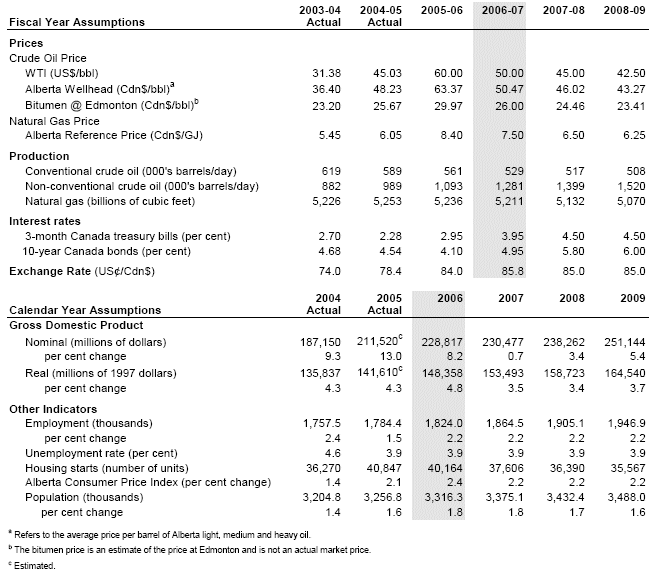

|
| |
| RISKS
TO THE ECONOMIC OUTLOOK |
 |
- Oil and Gas Prices
- There is significant uncertainty
over energy prices. A greater than expected decline in world
energy prices could negatively impact Alberta's energy sector
and reduce government revenues.
- Higher than forecast energy
prices would increase government revenues, but global economic
growth could be negatively affected.
- Tight Alberta Labour Market
- Tight labour markets and the
robust Alberta economy could exacerbate wage pressures making
some sectors less competitive. Inflationary pressures, particularly
in the construction sector, could dramatically increase government
and private sector infrastructure costs.
- Inflationary Pressures and Higher
Interest Rates
- Current increases in overall
consumer and wholesale prices could cause inflationary pressures
to emerge. Monetary authorities could respond by raising short-term
rates higher than expected, triggering slower world growth.
- Strong Canadian Dollar
- A stronger-than-expected Canadian
dollar could negatively affect exports and economic growth.
Oil and gas activity could also be negatively affected due
to lower returns for energy exporters. A high Canadian dollar
also lowers government resource revenues, as energy prices
and contracts are mainly based on the U.S. dollar.
- U.S. Budget and Current Account
Imbalances
- Has the potential to disrupt
world financial markets and significantly reduce the U.S.
and global economic growth in the medium term.

|
| |
| SENSITIVITIES
TO FISCAL YEAR ASSUMPTIONS, 2006-07 |
 |


|
| |
| TABLES
AND CHARTS |
| |
| GLOBAL
GROWTH TO REMAIN STRONG |
 |

- The global economy grew by an
estimated 4.3 per cent in 2005. Growth was strongest in China
and India, robust in the United States and anemic in Europe.
- The global economy is forecast
to grow by 4 per cent in 2006. China and India are expected
to lead growth, with China expected to advance by 9 per cent
and India by 7 per cent.
- In the United States, Canada's
largest trading partner, growth of 3 per cent will be supported
by strong business investment and government expenditures. Rising
interest rates and higher energy prices are likely to slow the
pace of consumer expenditures.

|
|
STEADY
ECONOMIC GROWTH IN CANADA |
|
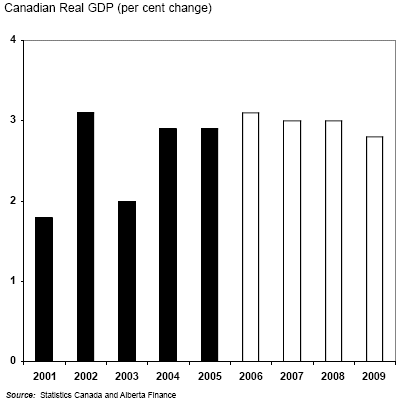
- Canada’s real GDP grew by 2.9
per cent in 2005, due to strong domestic demand.
- Domestic demand in Canada strengthened
in 2005, with investment accelerating and consumer spending
remaining strong. The external sector was a drag on growth as
the higher Canadian dollar and continued competition from Asian
countries boosted imports, while exports posted only moderate
growth.
- Although the Canadian economy
remains fundamentally sound, a higher dollar and rising interest
rates are expected to keep a lid on Canada's growth. Economic
growth is forecast to average 3 per cent in 2006 and over the
medium term.

|
|
CANADIAN
JOB GROWTH MODERATES |
|
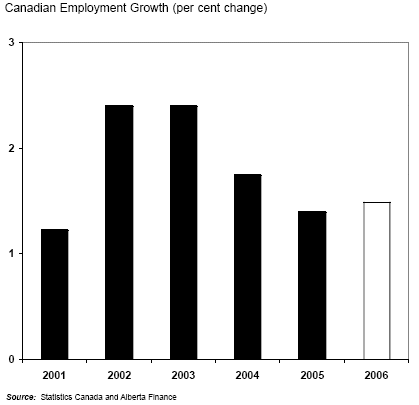
- Despite steady GDP growth in 2005,
employment growth in Canada slowed to 1.4 per cent. The slower
pace of employment growth in 2005 reflected a pick up in labour
productivity, which was up 1.1 per cent in 2005.
- In 2005, Canada's unemployment
rate fell to 6.8 per cent, its lowest level in three decades,
with the exception of 2000. The decline was driven by slower
growth in the labour force, which grew by only 0.9 per cent.
- Canadian employment growth is
expected to average 1.5 per cent in 2006 over the medium term.

|
|
INFLATION
CONTAINED DESPITE HIGHER ENERGY PRICES |
|
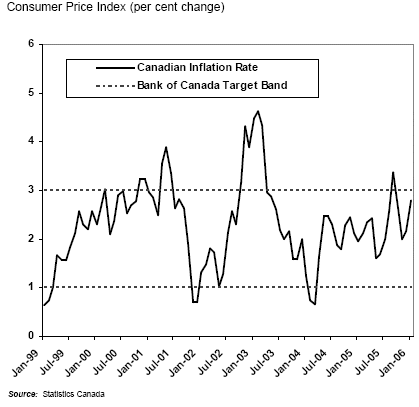
- Energy prices were a major driver
of global inflation in 2005. As a result, overall Canadian inflation
rose to 2.2 per cent in 2005 from 1.9 per cent in 2004. However,
core inflation (excluding food and energy) was 1.4 per cent,
well within the Bank of Canada's target band of 1 to 3 per cent.
- With strong economic growth,
Alberta's CPI inflation increased to 2.1 per cent in 2005 from
1.4 per cent in 2004.
- Rising cost pressures in Alberta
are likely to keep Alberta’s inflation rate somewhat higher
than the national average. Alberta’s inflation rate is expected
to average 2.2 per cent over the forecast period, compared to
2 per cent in Canada.

|
|
INTEREST
RATES ARE RISING |
|
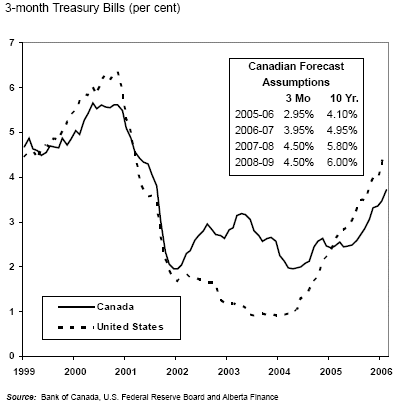
- U.S. interest rates have been
rising steadily since mid-2004. Currently at 4.5 per cent, they
are approaching their peak for this economic cycle.
- Canadian interest rates have also
risen and were at 3.75 per cent as of March 7, 2006, 75 basis
points below U.S. rates.
- With the Canadian economy operating
at full capacity, higher commodity prices and rising wages are
putting upward pressure on inflation. The Bank of Canada is
expected to continue to raise short-term interest rates in the
near term, with rates peaking at 4.5 per cent in 2007-08.

|
|
CANADIAN
DOLLAR REACHES A 14-YEAR HIGH |
|

- Higher commodity prices, solid
economic growth and expectations of rising interest rates lifted
the Canadian dollar to a 14-year high above 88 cents US in early
2006. The dollar is estimated to have averaged 84 cents US in
2005-06.
- The increase in the Canadian
dollar against non-U.S. currencies was even more pronounced,
as the U.S. dollar appreciated against most major world currencies
in 2005.
- The Canadian dollar is expected
to remain strong in 2006 on prospects of rising short-term interest
rates and continued solid growth in Canada. Over the medium
term, the Canadian dollar is likely to settle around 85 cents
US.

|
|
OIL
PRICES REACH RECORD LEVELS |
|

- In fiscal 2005-06, oil prices
are estimated to have averaged US$60/bbl, up 33 per cent from
the previous year.
- Hurricane production losses, lower
world oil capacity, which fell to its lowest levels in over
three decades, and political uncertainties in oil exporting
countries drove prices higher in 2005.
- Anticipated increases in global
oil production in response to current high prices are expected
to ease supply constraints over the forecast period. Experts
believe the sustainable long-term price for oil has increased
to US$40/bbl from around US$30/bbl, reflecting the assumption
that increases in crude oil capacity will no longer be adequate
to support rising world oil demand, especially from emerging
Asia.

|
|
NATURAL
GAS PRICES SOAR AFTER HURRICANES |
|
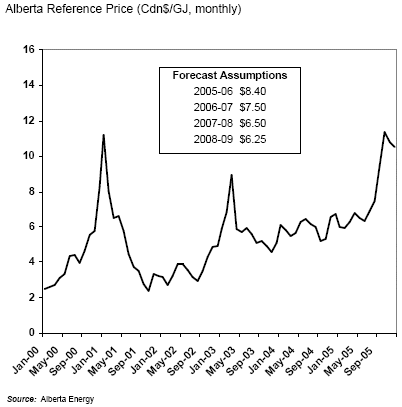
- Natural gas prices averaged an
estimated $8.40 per gigajoule (GJ) in 2005-06. Natural gas prices
followed oil prices higher in the first eight months of 2005
and then spiked as a significant amount of North American natural
gas production was lost due to damage from hurricanes Katrina
and Rita.
- Natural gas prices have eased
recently, reflecting a warmer than normal North American winter
and production recovery in hurricane-affected areas. Prices
are expected to average C$7.50/GJ in 2006-07.
- Over the medium term, natural
gas prices are expected to moderate, but rising demand for natural
gas, coupled with decreasing supply, are likely to keep natural
gas prices higher than the historical average.

|
|
STRONG
ECONOMIC GROWTH TO CONTINUE IN ALBERTA |
|
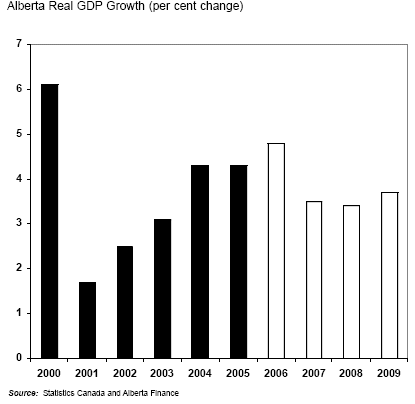
- Alberta's economy is projected
to advance by 4.8 per cent in 2006, the strongest growth since
2000.
- Following growth of 4.8 per cent
in 2006, the economy is forecast to grow by an annual average
rate of 3.5 per cent per year over the medium term, 0.5 percentage
points higher than Canada and the United States.

|
|
CONVENTIONAL
ENERGY SECTOR BUILDS ON RECORD ACTIVITY |
|
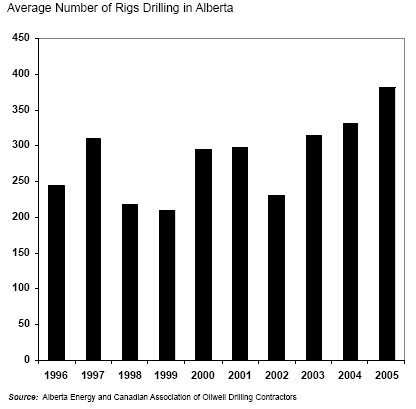
- For the third consecutive year,
Alberta's conventional oil and gas sector enjoyed a record year
of activity, with the number of rigs drilling increasing by
15.3 per cent in 2005. Most of the drilling activity in 2005
was directed towards natural gas. The rig utilization rate rose
by 5.7 percentage points to 67 per cent in 2005, pushing up
demand for labour and equipment.
- While energy prices are forecast
to moderate, they are expected to remain relatively high by
historical standards, sustaining drilling activity at healthy
levels throughout the forecast period. Increased drilling for
natural gas is needed to maintain existing production, as output
per well is declining.

|
|
OIL
SANDS INVESTMENT SURGES IN 2005 |
|
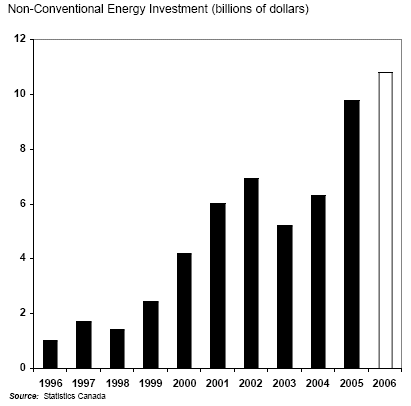
- Alberta's oil sands represent
the second largest oil reserves in the world, after Saudi Arabia.
Oil sands investment increased dramatically, rising from $1
billion in 1996 to approximately $6.9 billion in 2002.
- Oil sands investment surged to
an estimated $9.8 billion in 2005 as high energy prices encouraged
companies to increase outlays in oil sands projects.
- Oil sands investment is expected
to be $10.8 billion in 2006 and remain high over the medium
term, as there are numerous projects under construction or planned
over the forecast period. Close to $20 billion has been committed
to oil sands projects.

|
|
NON-CONVENTIONAL
OIL PRODUCTION TAKES OFF |
|

- Oil production increased modestly
in 2005 reflecting the effects of a fire at Suncor’s plant and
an extended maintenance-related shutdown at the SynCrude facility
in Fort McMurray. With the resumption of full production at
these facilities and increased production at numerous ongoing
and recently completed projects, Alberta’s total oil production
is estimated to increase by 14 per cent in 2006.
- With oil sands investment remaining
high, non-conventional oil will represent an ever-increasing
share of Alberta’s total oil production. By 2009, non-conventional
oil is expected to increase to about 77 per cent of total production,
up from 63 per cent in 2005.

|
|
HOUSING
STARTS REACH 27-YEAR HIGH |
|
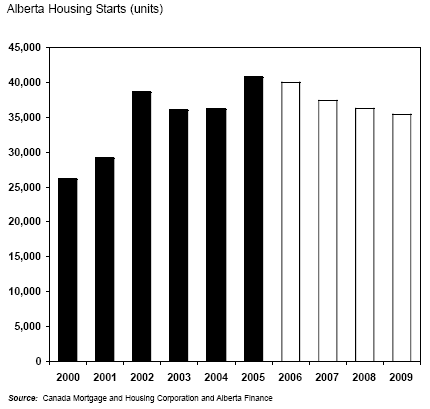
- Alberta housing starts totaled
40,847 in 2005, its highest level since 1978.
- Lower long-term mortgage rates
and robust labour markets have fuelled residential construction.
Alberta’s housing sector received further support from our strong
economy and more people moving to Alberta.
- Strong growth in income and gains
in population are likely to keep housing starts high, with starts
above 40,000 in 2006 and averaging over 36,000 per year between
2007 and 2009.

|
|
ALBERTA
CONSTRUCTION PRICES INCREASE |
|
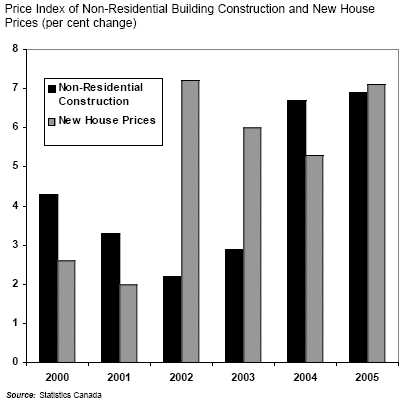
- The price index of non-residential
construction rose by 6.9 per cent in 2005. This increase was
the result of higher fuel, material (steel and concrete) and
labour costs, as well as a strong market for construction.
- Alberta new home prices increased
by 7.1 per cent in 2005, also reflective of increased material
and labour costs, as well as a strong housing market.
- Wages and salaries in the construction
industry rose by 14 per cent in 2005, while employment in construction
remained constrained by relatively flat labour supply.

|
|
STRONG
GROWTH LEADS TO HIGHEST WAGES IN CANADA |
|
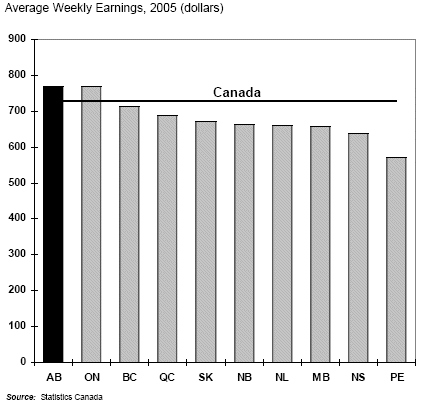
- The province is experiencing tight
labour markets with an unemployment rate below 4 per cent. Some
regions, including Wood Buffalo (Fort McMurray), Athabasca and
Camrose, are experiencing unemployment rates below 3 per cent.
In particular, a lack of skilled workers is being reported,
which is putting upward pressures on wages in Alberta.
- Alberta's labour income grew
by 9.4 per cent in 2005, the highest rate of growth among provinces.
Strong growth in the number of full-time jobs and wages contributed
to the stellar gain in labour income.
- In 2005, Alberta's average weekly
earnings was the highest among provinces, growing by 5.2 per
cent, 2.1 percentage points above the Canadian average of 3.1
per cent.

|
|
HIGHEST
DISPOSABLE INCOME IN CANADA |
|
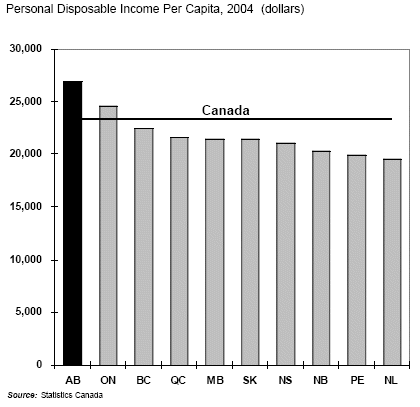
- At $26,961, Alberta had the highest
average personal disposable income of any province in 2004,
the latest year for which data is available. Alberta's high
participation rate, strong growth in wages, and low personal
taxes all support the strength in personal disposable income.
- In 2004, Alberta's disposable
income per capita was $3,583 (15.3 per cent) above the Canadian
average of $23,378.
- With strong gains in employment
and wages, Alberta's per capita disposable income is expected
to remain high over the forecast period.

|
|
RETAIL
SALES CONTINUE GROWTH |
|
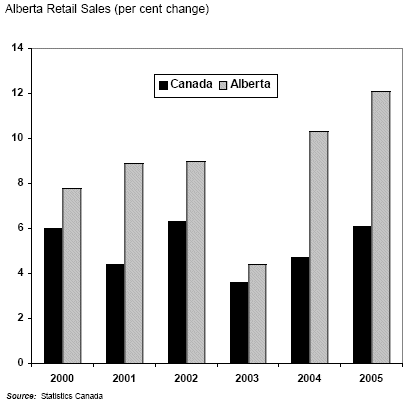
- Strong growth in wages and employment
has spurred exceptional growth in consumer expenditures in Alberta.
In 2005, retail sales increased by 12.1 per cent, nearly double
the Canadian average of 6.1 per cent.
- In 2006, retail trade is expected
to remain strong, supported by continued growth in wages, employment
and higher net migration, as well as the $400 prosperity cheques
sent to every Albertan in early 2006.
- Over the forecast period, retail
sales are expected to grow by an average 6 per cent per year.

|
|
BORDER
REOPENS TO CATTLE BUT CROPS STRUGGLE |
|

- The U.S. border reopened to Canadian
live cattle under the age of 30 months in July 2005, allowing
Alberta to export over 213,000 live cattle to the United States
in 2005. Livestock prices have improved since the opening of
the border, but were down 10 per cent for all of 2005, the fourth
consecutive annual decline.
- For the second year in a row,
poor harvesting weather affected the quality of crops in some
parts of the province. Rising inventory levels from two years
of high crop production, combined with reduced crop quality
and a world oversupply of grain, caused prices to fall 22 per
cent in 2005.
- Overall, Alberta's farm cash receipts
were down 1.7 per cent in 2005. A decline in crop receipts (-11
per cent) and program payments (-22 per cent) outweighed the
improvement in livestock receipts (+12 per cent).

|
|
ALBERTA'S
EXPORTS CONTINUE TO INCREASE |
|

- Despite the rising Canadian dollar,
Alberta's exports increased by an estimated 2.4 per cent in
2005. Manufacturing, coal and sulfur exports led growth.
- Overall, Alberta's exports are
expected to rise by 5.7 per cent in 2006 due to a positive outlook
for exports of non-conventional oil and live animals. For the
forecast period, export growth is expected to average 3.3 per
cent per year.
- Future growth will be increasingly
driven by non-conventional oil, manufacturing and other services.
Exports of natural gas are expected to decline, as consumption
of natural gas within Alberta is expected to increase and production
is expected to decline modestly.

|
|
ALBERTA
CONTINUES TO SEE GAINS IN EMPLOYMENT |
|
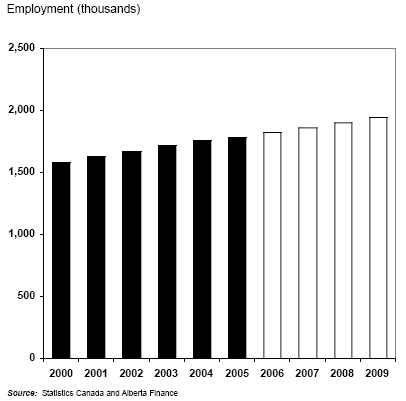
- Employment in 2005 reached a record
1,784,400 jobs and has shown steady growth over the past 13
years.
- Alberta employment levels increased
by 1.5 per cent in 2005. The switch from part-time employment
(-10,400 jobs) to full-time employment (+37,400 jobs), along
with strong income gains, illustrates the improvement in the
quality of jobs and earning potential for Albertans in 2005
and in the coming years.
- Continued strong growth in economic
activity is expected to generate average annual employment growth
of 2.2 per cent in Alberta over the medium term. Higher migration
levels are expected to ease the current tight labour market
conditions.

|
|
ALBERTA
- THE DESTINATION OF CHOICE |
|

- In 2005, for the tenth consecutive
year, Alberta had positive net interprovincial migration. Alberta
had the highest level of net interprovincial migration of any
province for the ninth consecutive year, with 16,615 Canadians
moving to Alberta.
- Despite improving economic conditions
in other regions of Canada, Alberta remains the destination
of choice for Canadians moving from other provinces. Higher
wages and a low unemployment rate are attracting more people
to Alberta. In the third quarter of 2005, Alberta gained a total
of 13,110 people from other provinces, the highest quarterly
total since the second quarter of 1998.
- Over the medium term, 20,000 migrants
per year are expected to move to Alberta from other provinces.

|
|
LOWEST
UNEMPLOYMENT RATE IN TWO DECADES |
|

- Alberta’s unemployment rate averaged
3.9 per cent in 2005, 0.7 percentage points lower than in 2004
and the lowest in over two decades.
- Alberta's 2005 unemployment rate
was the lowest among provinces and was 2.9 percentage points
below the Canadian average of 6.8 per cent.
- Alberta's unemployment rate is
projected to stay the lowest among provinces over the forecast
period. With solid growth in employment and economic activity,
the Alberta economy is expected to remain at full employment
levels over the forecast period.

|
|
OIL
PRICE FORECAST BENCHMARK |
|


|
|
TRACKING
THE FORECASTS OF OIL PRICES |
|
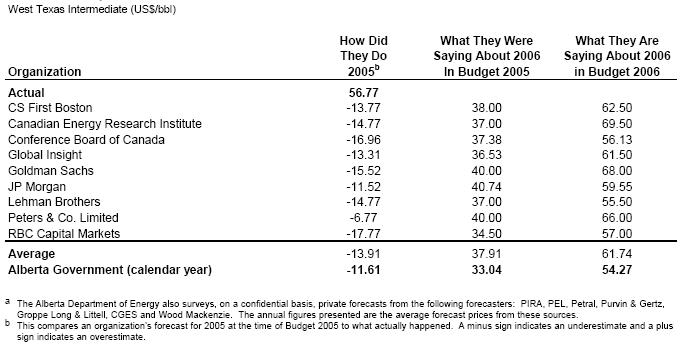

|
|
NATURAL
GAS PRICE FORECAST BENCHMARK |
|


|
|
TRACKING
THE FORECASTS OF NATURAL GAS PRICES |
|
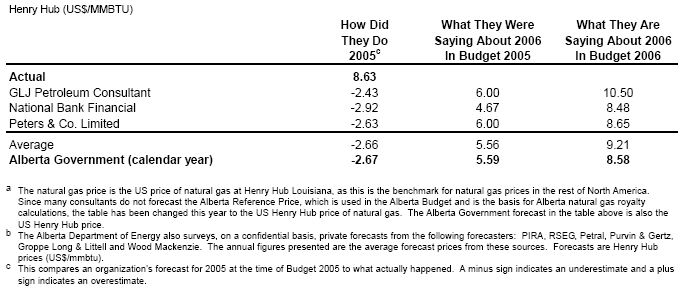

|
|
CANADIAN
SHORT-TERM INTEREST RATE FORECAST BENCHMARK |
|
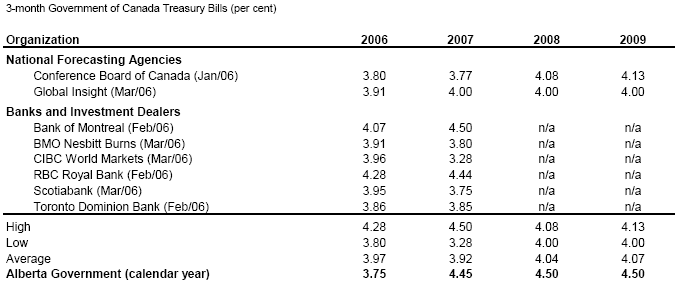

|
|
CANADIAN
LONG-TERM INTEREST RATE FORECAST BENCHMARK |
|


|
|
CANADA/UNITED
STATES EXCHANGE RATE FORECAST BENCHMARK |
|
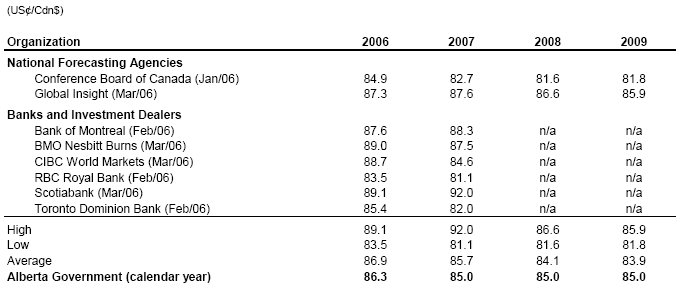

|
|
ALBERTA
REAL GROSS DOMESTIC PRODUCT FORECAST BENCHMARK |
|


|
|
| ANNOUNCED
MAJOR PROJECTS OVER $100 MILLION |
 |
Announced
or Under Construction
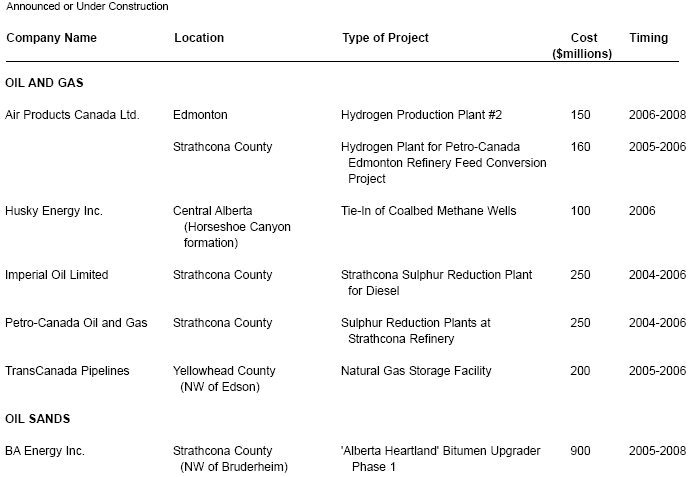
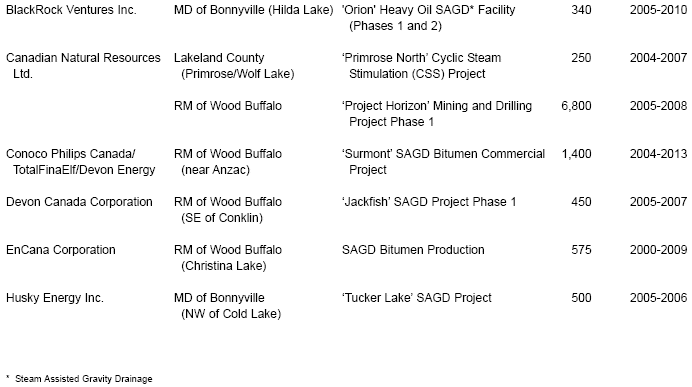








|
|
|










